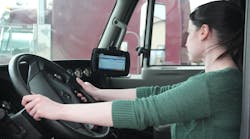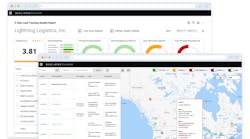ORLANDO. As the December 18 deadline for the electronic logging devices (ELD) mandate to go into full effect, a panel discussion here at the American Trucking Associations (ATA) 2017 Management Conference & Exhibition (MC&E) sorted through a variety of issues and opportunities related to the technology.
Joe DeLorenzo, director of the office of compliance and enforcement at the Federal Motor Carrier Safety Administration (FMCSA), stressed that the “reason at the root of why we’re doing this” in terms of mandating ELDs is to improve compliance with hours of service (HOS) regulations.
“The biggest thing to remember is that it is really still about HOS enforcement; all we’re really doing is moving from paper logs to electronic records,” he said.
To that end, though, Collin Mooney – executive director of the Commercial Vehicle Safety Alliance (CVSA) – emphasized that HOS enforcement “does not change” and that inspectors will document “all ELD and HOS violations” starting December 18. They just won’t be placing trucks out of service for ELD violations until April 1 next year.
He stressed that the three and half month period between December 18 and April 1 won’t be a “soft enforcement” period – warnings and citations for ELD violations during roadside inspections will be issued.
That can have a major impact on its Compliance Safety Accountability (CSA) scores, noted FMCSA’s DeLorenzo. “The tricky issue with CSA is that the program treats an inspection, an inspection with a warning, and an inspection with a violation all the same,” he explained – one of many inconsistencies within CSA noted in a report issued by the National Academies of Sciences, Engineering, and Medicine (NAS) back in late June.
That’s also problematic as some industry surveys indicate many drivers and fleets haven’t adopted ELDs yet.
During a separate press event here at the conference, Wade Wilson, CEO of Pedigree Technologies, estimated that 2.8 million truck drivers do not have an ELD yet – that’s out of a population of 3.1 million commercial driver’s license (CDL) holders in the U.S.
CVSA’s Mooney also noted that all but two states have adopted the ELD rule into their statutes and that those remaining two are “on track” to have it done by December 18.
He added that a two-week “train the trainer” course for enforcement personnel regarding ELDs kicks off soon and thus Mooney expects inspectors will be ready by the December 18 deadline to properly enforce the mandate’s rules.
The panel addressed a wide range of other ELD details during the two-hour session:
- ELDs are not required for pre-2000 model year trucks, but that “model year” designation is tied to the engine, not the chassis, FMCSA’s DeLorenzo noted. Thus a 2001 model year truck with a 1999 engine would be exempt.
- Automatic onboard recording devices (AOBRDs) – the technological precursor to ELDs – can continue to be used until December 16, 2019, and can be transferred to a new truck after the December 18 deadline this year only if that truck is a replacement unit, DeLorenzo said. AOBRDs cannot be installed in “new capacity” after December 18, he stressed.
- Paper logs can currently be “annotated” to provide extra detail and that same “annotation” capability is present in the ELD specifications laid out by FMCSA, DeLorenzo noted. That becomes crucial when using the “adverse driving condition” part of the rule that allows for two extra hours of drive time in case of weather emergencies such as a sudden snow storm. “This would be the time to annotate an ELD entry,” he explained.
- Personal conveyance is “optional” under the ELD rule, DeLorenzo said: “It’s based on a motor carrier’s decision whether or not to use it.” He added that GPS tracking is made less accurate when in “personal conveyance” mode, expanding from an accuracy of one mile to 10 miles to provide drivers more “privacy.”
- One way to account for “unassigned miles” is to establish an “exempt driver” account for maintenance technicians and yard jockeys. “That way there are no ‘unassigned miles’ a driver must account for,” DeLorenzo noted.
- There are as of now 135 self-certified devices on FMCSA’s ELD list. What happens if that certification gets revoked by the agency for non-compliance with its ELD specifications at some point down the road? “We plan to address that on a case-by-case basis,” DeLorenzo said.
On a separate note, he reiterated that the agency is still planning to move forward with a split-sleeper berth study announced back in June but has still not “decided on the specifics” of that study, though DeLorenzo said it would be “naturalistic” and “long term.”
Jim Ward, president and CEO of 400-truck TL carrier D.M. Bowman, shared his fleet’s five-year experience with electronic logs, noting that one reasons ELDs are such a contentious issue within the industry is because so many trucking companies are small businesses.
“Out of 537,000 registered motor carriers, 97% operate 20 trucks or less and 91% operate six trucks or less,” he explained. “That’s why this [ELD rule] has such a huge impact.”
Ward said D.M. Bowman switched over to AOBRDs in 2012 and noted that while productivity declined initially and that there was “pushback” against adoption of the devices, with “a handful” of drivers leaving as a result, “we’d have a mass exodus if we took them out of the trucks now.”
He noted that the way D.M. Bowman encourage AOBRD adoption was to make their use contingent on a driver getting a “new truck” and that the fleet is using the same process as it adopts ELDs, of which it is testing 50 units right now.
Ward added that the data gleaned from D.M. Bowman’s AOBRDs has helped it address productivity and efficiency issues with its customers; something he expects will continue as the fleet switches over to ELDs.
“Data tells the truth about what is going on; provides opportunity for conversation with shippers on carrier productivity and efficiency,” he said, noting that a white paper issued by J.B. Hunt Transportation Services two years ago showed that truck drivers only averaged about six and a half hours of actual driving every day.
“Our industry has matured quite well in terms of how we use data,” Ward stressed. “We have an opportunity to take that data [from ELDs] to get better as an industry.”






